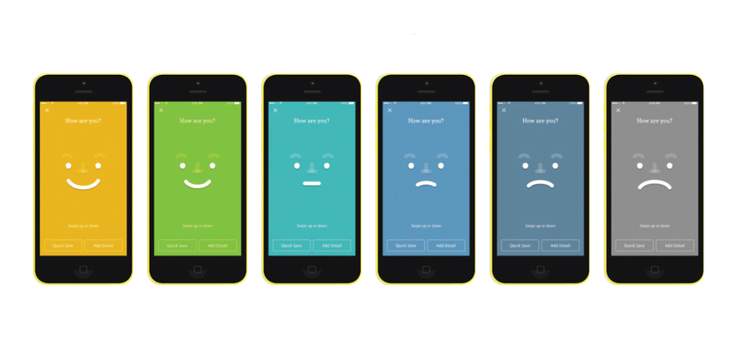In 36 hours, systems analyst Marc Balaban built an app that let users type a worrying thought into a bubble and watch it float away. Within two hours of mentioning pixelthoughts.co on reddit, the app went viral. Why? While there’s dozens of apps out there that let you click emojis to track your mood, there’s very few that let you sit with your feelings or investigate them.
A more sophisticated emotion-tracking app surfaced this summer: Moodnotes ($3.99 for IOS) allows you to journal your feelings so you can better understand and relate to them. Created by clinical psychologists Edrick Dorian and Drew Erhardt of Thriveport and London design studio Ustwo, Moodnotes is based in cognitive therapy, a form of therapy where psychologist and patient work together to evaluate patterns of thinking that are unhelpful and work to change them. “We teach in therapy for people to pay attention to their mood shifts,” says Dorian. “When you reflect on what’s going through your mind, you really have an opportunity to see your thoughts as something separate from reality, that you can observe.”
Building better habits of mind
The app walks you through a series of questions, which all begins by manipulating a digital face. If you input a feeling into the box, the app might ask if you can identify thinking traps, and if you can consider the situation in a different light.
“The journaling process disguises a fairly sophisticated cognitive restructuring process,” says Dorian. “Much like in therapy or as part of therapy homework, people learn through practice how to catch themselves thinking in erroneous or distorted ways and how to correct their own thinking so that it’s more helpful.”
“The goal is not to get rid of the negative thoughts but rather to be skilled in evaluating them and knowing that just because you have a negative thought doesn’t mean it’s true.”
In other words, users learn how to evaluate their thinking. It’s not about banishing bad thoughts and pumping out good ones (although seeing a group of frowning faces in your journal might compel you to create some positive entries). It’s about becoming familiar with how your own mood shifts and what impacts your mood and mood intensity.
“The goal,” says Dorian, “is not to get rid of the negative thoughts but rather to be skilled in evaluating them and knowing that just because you have a negative thought doesn’t mean it’s true.”
Mindful journaling exercise
When you experience a negative shift in your mood, you can pause and ask yourself the following questions:
- “What was happening right before I started to feel this way?” (who, what, when, where)
- “What thoughts or images were going through my mind?”
- “What was the specific thought or conclusion that I came to that lowered my mood or upset me?”
After identifying that thought, it’s important to evaluate it for any thinking traps. Thinking traps are ways in which we convince ourselves that something is true or rational, when in fact it is not. By eliminating traps from our thinking, we are able to positively influence our emotions and behaviors.
- For example, you might learn that you are falling in the catastrophizing trap. That is, you are blowing a situation out of proportion or seeing it in the worst possible way.
- To shift your thinking and get out of the catastrophizing thinking trap, you might ask yourself:
- “Is the situation as bad as I’m making it out to be?”
- “Have I been able to handle something like this in the past?”
- Then…
- “What’s a healthier way that I can think about this?”
By answering these questions, you can replace your original thought with something more accurate and rational. Your mood will improve and you’ll begin to see how you can break free from thought traps that might be common to you.






